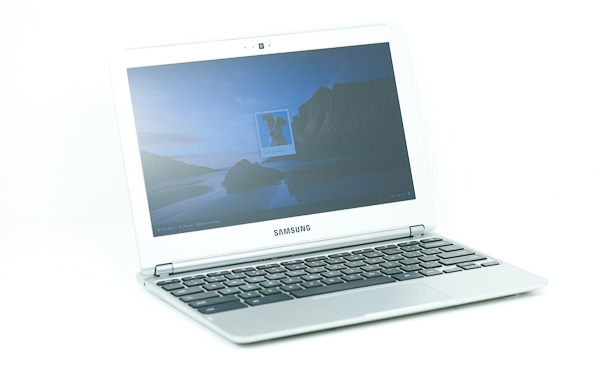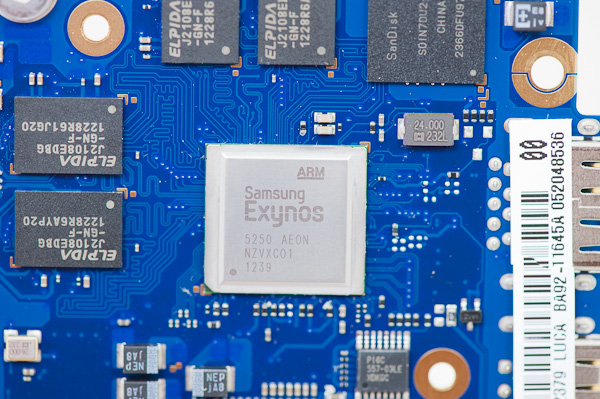Samsung Chromebook (XE303) Review: Testing ARM's Cortex A15
by Anand Lal Shimpi on October 31, 2012 9:00 AM ESTGoogle announced the Chrome OS project two years ago, and with it came the first Chromebook: the CR-48. The Chrome OS concept seemed revolutionary at the time. In 2010 we were well into the latest round of questioning whether today's PCs were fast enough. The Ultrabook revolution hadn't yet begun, and the iPad was starting to gain momentum. Capitalizing on the market being flooded with poor quality, yet affordable PC notebooks that still struggled with the same virus/malware issues they'd been facing for years, Google took the opportunity to attempt to revolutionize the PC OS.
Chrome OS was that attempt at a revolution. As an OS built around a web browser, Chrome OS offered many of the advantages that the Chrome browser itself brought to the table: sandboxing, guest mode and constant/painless updates. All user data is encrypted on the drive by default. Security was and remains a major feature of Chrome OS.
Google's revolution extended to hardware as well. The Cr-48 notebook delivered a good keyboard, trackpad and solid state storage. Future Chromebooks would do the same. While the price points of these machines (<$500) kept ultra high resolution IPS displays out of the bill of materials, Google promised good build quality and solid state storage - two things you couldn't find in cheap notebooks of the time.
Since then, some of the traditional PC makers have woken up. Although confined to the $999+ price point, we're finally seeing attention paid to build quality, display quality and storage performance. Over the next couple of years there's going to be increased focus on bringing those premium features down to sub $700 price points.
For Chrome OS and Google's Chromebooks to remain relevant, they also had to move down the pricing stack. With its most recent announcement, Google has done just that. The new Chromebook (Samsung XE303C12) is priced at $249, while maintaining much of what made its predecessors interesting.
Even more interesting than its aggressive price point is the choice of SoC inside Google's new Chromebook: Samsung's Exynos 5 Dual, featuring two ARM Cortex A15 CPU cores. This move makes the new Chromebook the very first non-x86 machine to ship with Chrome OS. Given that I also happen to have a dual-core Atom based Chromebook from 2011, the new Exynos 5 based machine gave me a unique opportunity to get a preview of how ARM's next-generation CPU core would stack up against Atom.













149 Comments
View All Comments
rootheday - Wednesday, October 31, 2012 - link
sure, the Atom N570 on 45nm is not so competitive on power and performance but I think it is misleading to compare A15 vs this rev of Atom because newer and better Intel processors are available....I think more interesting comparison point for future competitors to A15 would be:
Acer Aspire One 756 - 11.6" notebook with Sandybridge Pentium or Celeron - I have seen it as low as $290 at Best Buy and Costco. Similar price point but way more performant.
Clovertrail based machines - reviewed on this site.. http://www.anandtech.com/show/6340/intel-details-a...
... while this is Win8 not ChromeOS, I would expect power and performance to be similar.
Krysto - Thursday, November 1, 2012 - link
I bet those don''t look as good as the Chromebook either. You're paying for the whole package.Midwayman - Wednesday, October 31, 2012 - link
I just wish the Surface had shipped with this SOC. Windows RT sounds more interesting than chrome, but it got saddled with a much older SOC in a product twice the cost.andrewaggb - Wednesday, October 31, 2012 - link
me too. If surface had this SOC with a higher res screen, I'd buy one. Instead I'm waiting for a hardware refresh. Tegra3 and atom are too slow, i5 is too power hungry.amdwilliam1985 - Wednesday, October 31, 2012 - link
I agree, Tegra 3 and current Atom are too slow, but the upcoming Atom should be better. I'm considering buying that instead of windows RT as a media pc replacement.I'm hearing a lot of miracast, has anyone coming out with the dongle yet? anything decent in the retail?
jeffkro - Wednesday, October 31, 2012 - link
Haswell should make a pretty nice media PC. Its suppose to be really good with power consumption especially if you get into the ULV versions. If your media PC is plugged into the wall the difference between 10W or 20-30W isn't that big of a deal. I'm pretty big into HTPC and I'm probably going to swap out my llano system for haswell when the i3 or pentium versions are released.amdwilliam1985 - Wednesday, October 31, 2012 - link
Sorry, I probably mislead you.What I'm looking for is surface type of tablet when I want to work on a tablet, and then I can dock it on my coffee table and use miracast as a wireless mirror display. That way, I can get rid of laptop, tablet and media pc and use 1 device only.
Currently I have an old core 2 duo laptop plug in 24/7 with a hdmi display and a wireless mouse as a media pc. The laptop is getting old and a replacement is needed soon.
wsw1982 - Thursday, November 1, 2012 - link
the samsung a15 is also 6+ w range soc according to the reviewKrysto - Thursday, November 1, 2012 - link
Anand has said Haswell will have higher TDP than IVB on the same level of performance. That 10W variant is just a significantly lower powered version.tipoo - Wednesday, October 31, 2012 - link
Agreed, even WP8 got a better SoC than T3 (Krait). Odd choice. Snapdragon S4 Pro in the surface would have been nice.